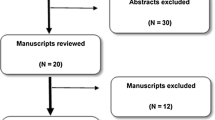Abstract
Purpose
To determine whether laparoscopic-assisted gastrostomy (LAG) has superseded percutaneous endoscopic gastrostomy (PEG) based on the clinical outcomes.
Methods
A retrospective study was undertaken for the period January 06–December 09. Demographic and clinical outcomes were recorded and the two groups were compared.
Results
164 patients were studied (PEG, n = 107; LAG, n = 57). 93.5 % of PEG patients required two general anaesthetics compared with 8 % of LAG patients. Median time to using the gastrostomy was 24 (range 0–168) h in PEG and 0 (0–96) h in LAG patients (p < 0.001). Major complications occurred in 15/107 (14 %) of PEG and 2/57 (3.5 %) of LAG patients (p = 0.05). Re-operation rate following complications was 18/107 (16.8 %) for PEG and 3/57 (5.2 %) for LAG (p = 0.05). Minor complications arose in 41/107 (38 %) of PEG and 32/57 (56 %) of LAG (p = 0.05). Post-operative hospital stay was 2 (1–40) days for PEG and 2 (0–20) days for LAG (p = 0.01). The day-case rate was 0/107 for PEG and 5/57 (9 %) for LAG. There was no gastrostomy-related mortality in the series.
Conclusion
LAG requires fewer anaesthetics, is associated with shorter time to feeding, shortened hospital stay and has a reduced risk of major complications. LAG is a very good alternative to the PEG in children.






Similar content being viewed by others
References
Gauderer MW, Ponsky JL, Izant RJ Jr (1980) Gastrostomy without laparotomy: a percutaneous endoscopic technique. J Pediatr Surg Dec 15:872–875
Vervloessem D, van Leersum F, Boer D et al (2009) Percutaneous endoscopic gastrostomy (PEG) in children is not a minor procedure: risk factors for major complications. Sem Pediatr Surg 18:93–97
Patwardhan N, McHugh K, Drake D et al (2004) Gastroenteric fistula complicating percutaneous endoscopic gastrostomy. J Pediatr Surg 39:561–564
Chang PF, Ni YH, Chang MH (2003) Percutaneous endoscopic gastrostomy to set up a long-term enteral feeding route in children: an encouraging result. Pediatr Surg Int 19:283–285
Sathesh-Kumar T, Rollins H, Cheslyn-Curtis S (2009) General paediatric surgical provision of percutaneous endoscopic gastrostomy in a district general hospital—a 12-year experience. Ann R Coll Surg Engl 91:404–409
Akay B, Capizzani TR, Lee AM et al (2010) Gastrostomy tube placement in infants and children: is there a preferred technique? J Pediatr Surg 45:1147–1152
Rothenberg SS, Bealer JF, Chang JH (1999) Primary laparoscopic placement of gastrostomy buttons for feeding tubes. A safer and simpler technique. Surg Endosc 13:995–997
Lantz M, Hultin Larsson H, Arnbjörnsson E (2010) Literature review comparing laparoscopic and percutaneous endoscopic gastrostomies in a pediatric population Int J Pediatr (507616) 1687–9740;1687–9759. Epub
Jones VS, La Hei ER, Shun A (2007) Laparoscopic gastrostomy: the preferred method of gastrostomy in children. Pediatr Surg Int 23:1085–1089
Zamakhshary M, Jamal M, Blair GK et al (2005) Laparoscopic vs percutaneous endoscopic gastrostomy tube insertion: a new pediatric gold standard? J Pediatr Surg 40:859–862
Nah SA, Narayanaswamy B, Eaton S et al (2010) Gastrostomy insertion in children: percutaneous endoscopic or percutaneous image-guided? J Pediatr Surg 45:1153–1158
Park JH, Rhie S, Jeong SJ (2011) Percutaneous endoscopic gastrostomy in children. Korean J Pediatr 54:17–21
Calleja Aguayo E, Delgado Alvira R, Elías Pollina J et al (2010) The PEG: why wait? Circ Pediatr 23:24–27
Takahashi T, Okazaki T, Kato Y et al (2008) Laparoscopy-assisted percutaneous endoscopic gastrostomy. Asian J Surg 31:204–206
Smitherman S, Pimpalwar A (2009) Laparoendoscopic gastrostomy tube placement: our all-in-one technique. J Laparoendosc Adv Surg Tech Part A 19:119–123
Croshaw RL, Nottingham JM (2006) Laparoscopic-assisted percutaneous endoscopic gastrostomy: its role in providing enteric access when percutaneous endoscopic gastrostomy is not possible. Am Surg Dec 72(12):1222–1224
Author information
Authors and Affiliations
Corresponding author
Rights and permissions
About this article
Cite this article
Wragg, R.C., Salminen, H., Pachl, M. et al. Gastrostomy insertion in the 21st century: PEG or laparoscopic? Report from a large single-centre series. Pediatr Surg Int 28, 443–448 (2012). https://doi.org/10.1007/s00383-012-3079-5
Accepted:
Published:
Issue Date:
DOI: https://doi.org/10.1007/s00383-012-3079-5




